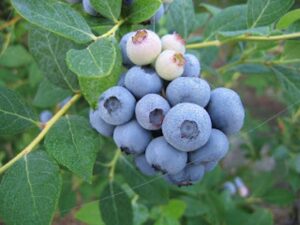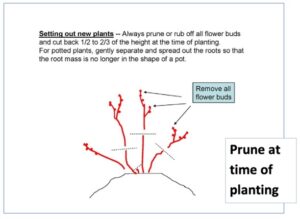Growing Blueberries in the Home Garden
go.ncsu.edu/readext?910990
en Español / em Português
El inglés es el idioma de control de esta página. En la medida en que haya algún conflicto entre la traducción al inglés y la traducción, el inglés prevalece.
Al hacer clic en el enlace de traducción se activa un servicio de traducción gratuito para convertir la página al español. Al igual que con cualquier traducción por Internet, la conversión no es sensible al contexto y puede que no traduzca el texto en su significado original. NC State Extension no garantiza la exactitud del texto traducido. Por favor, tenga en cuenta que algunas aplicaciones y/o servicios pueden no funcionar como se espera cuando se traducen.
Português
Inglês é o idioma de controle desta página. Na medida que haja algum conflito entre o texto original em Inglês e a tradução, o Inglês prevalece.
Ao clicar no link de tradução, um serviço gratuito de tradução será ativado para converter a página para o Português. Como em qualquer tradução pela internet, a conversão não é sensivel ao contexto e pode não ocorrer a tradução para o significado orginal. O serviço de Extensão da Carolina do Norte (NC State Extension) não garante a exatidão do texto traduzido. Por favor, observe que algumas funções ou serviços podem não funcionar como esperado após a tradução.
English
English is the controlling language of this page. To the extent there is any conflict between the English text and the translation, English controls.
Clicking on the translation link activates a free translation service to convert the page to Spanish. As with any Internet translation, the conversion is not context-sensitive and may not translate the text to its original meaning. NC State Extension does not guarantee the accuracy of the translated text. Please note that some applications and/or services may not function as expected when translated.
Collapse ▲Article adapted from NC State Extension Publication “Growing Blueberries in the Home Garden.”
Blueberries are a perennial favorite that can be grown in most home gardens in Pamlico County. Blueberries can be used in the landscape as hedges for screening purposes or as a single specimen plant. They have delicate white or pink flowers in the spring, with attractive sky-blue fruit in the summer, and great red and yellow colors in the fall. In addition, blueberries yield delicious fruit that many people desire. Should you wish to grow blueberries in your home garden, below are a few important considerations.
Blueberries require a lower soil pH than many other small fruit crops. Before planting, take a soil test and follow recommendations to adjust soil pH levels to 5.3 or less for rabbiteye blueberries or 5.0 or less for highbush blueberries. If the soil contains less than 2% organic matter (OM on soil test report), incorporating peat moss or well-decayed pine sawdust or bark will improve plant survival and growth.
Blueberry plants require excellent soil drainage, so provisions for drainage must precede planting. Use raised beds or mounds in areas that are prone to wetness. In most seasons and on most soils, irrigation is absolutely essential the year of planting. Hand watering with a hose is possible for several bushes, however, a soaker hose will usually give more uniform wetting. Apply irrigation no more than once every two days to reduce the chances of root rot infection. Full sun is also desirable for maximum yield, but up to 50% shade is usually acceptable.
Both highbush (Vaccinium corymbosum) and the rabbiteye (V. ashei) types of blueberries can be grown in Pamlico County. The rabbiteye is more drought and heat resistant and will tolerate a wider range of soil types than the highbush. For these reasons, rabbiteye is easier to establish and grow successfully on drier soils than highbush. Highbush varieties begin ripening in mid-May and Rabbiteye varieties begin in mid-June. Remember that more than one rabbiteye variety must be planted to provide the cross-pollination required for maximum yields. Here are a few suggested varieties in order of ripening from early to late that have been grown successfully and are recommended for homeowners:
- Highbush:‘O’Neal’ (southern highbush), ‘Morrow,’ ‘Reveille,’ ‘Croatan,’ ‘Murphy,’ ‘Bounty,’ ‘Blue Ridge’ (southern highbush), ‘Bluechip,’ ‘Jersey’
- Rabbiteye:‘Climax,’ ‘Premier,’ ‘Tifblue,’ ‘Powderblue,’
Bareroot and containerized plants are both available for purchase. Bareroot plants should be planted during late winter (February-March) and containerized plants can be planted almost year-round. It is essential for good growth that you remove approximately 2⁄3 of the top growth on bare-root plants and 1⁄2 on containerized plants at planting, leaving only 1-3 of the most vigorous upright shoots. In addition, remove any remaining flower buds (plump rounded buds), so that the plants will not flower the first year. Skipping this task will result in stunted slow growth.
Do not fertilize immediately after planting, but wait until the first leaves have reached full size, then apply one tablespoon of an azalea or acid loving plant fertilizer, 12-12-12 or 10-10-10, within a circle one foot from the plants. Repeat applications during the season may be needed, but use caution, as blueberries are easily damaged by excess fertilizer.
Mulching home blueberry plantings is the best form of weed control. If mulch is applied following planting and replaced at the rate of one inch per year, few weed problems should develop. Hand pull or hoe occasional weed growth and maintain a grass free area around plants. Blueberry roots grow near the soil surface, so be careful when weeding or applying herbicides near plants as roots can be easily injured.
For additional information on establishing blueberries in the home garden, refer to the NC State Extension homeowners guide. For a detailed description on how to prune blueberries, review the publication, Pruning Blueberries, from our Extension Blueberry specialist, Bill Cline.
If you have additional questions or would like to discuss this topic further, please contact Daniel Simpson at 252-745-4121 or daniel_simpson@ncsu.edu.






